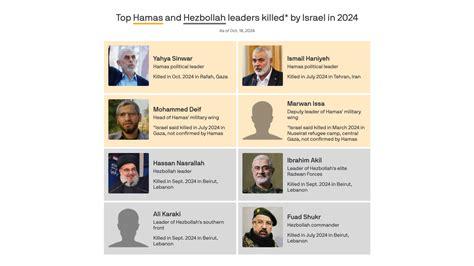
How Israel decimated Hamas and Hezbollah leadership in three months
One by one, Israel has tracked, targeted and eliminated the leadership of its greatest regional enemies in a sprawling decapitation operation with little precedent in modern history.
Why it matters:
The killing of Oct. 7 mastermind Yahya Sinwar this past week capped an astonishing three-month streak in which a succession of top Hamas and Hezbollah leaders, as well as several Iranian generals, were taken out by Israel.
The series of killings, a year after the Oct. 7 Hamas terrorist attacks, has dealt a crippling blow to the so-called “axis of resistance” Iran has been building, arming and funding for years.
While the death of Sinwar marked the most important symbolic victory, it was distinct in that it was not a targeted assassination — and not the product of a sophisticated operation or pinpoint secret intelligence.
Driving the news:
One of Israel’s top goals since the start of the war has been to kill the leaders of Hamas and any militants involved in the Oct. 7 attacks.
A special unit inside Israel’s domestic intelligence service, the Shin Bet, was formed to do exactly that.
U.S. intelligence services and special operation units worked with the Israelis for months to hunt down Sinwar and his deputies, investing a huge amount of intelligence and operational resources.
Time and time again, the forces got close to Sinwar inside the Hamas tunnels in southern Gaza — but time and time again, he managed to evade them.
When Sinwar was finally caught, it was pure coincidence.
The Israel Defense Forces unit that closed in on the house he was hiding in didn’t know the identity of the militants with whom they were exchanging fire.
The 19-year-old soldier who killed the most wanted man in the Middle East only discovered his historic accomplishment in hindsight.
Flashback:
As the fighting with Hezbollah on the northern border escalated in the days after Oct. 7, Israel also started targeting senior commanders of the Iranian-backed Shia militia.
Israel took out several Hamas and Hezbollah commanders in the first six months of the war. But a major breakthrough came in mid-July with the killing of the commander of Hamas’ military wing, Mohammed Deif, in an airstrike in southern Gaza.
It was the first time Israel had managed to kill one of the architects of the Oct. 7 attacks.
Two weeks later, Israel conducted an airstrike in Beirut and killed Hezbollah’s top military commander, Fuad Shukr — the biggest blow to the militia since Israel’s assassination of its previous military commander, Imad Mughniyeh, in 2008.
Another Israeli assassination was carried out less than a day later — this time in Tehran, where a bomb exploded in an Iranian government guesthouse and killed Hamas political leader Ismail Haniyeh.
In mid-September, Israel launched an unprecedented clandestine attack against Hezbollah — remotely detonating thousands of pagers and walkie-talkies.
The explosions left thousands of Hezbollah members killed or wounded, among them several senior officials.
Over the next few days, Israel carried out a series of unprecedented airstrikes that destroyed large parts of Hezbollah’s rocket and missile arsenals and killed many of its senior and mid-level commanders, including its head of military operations, Ibrahim Aki, and a dozen of the elite Radwan Force’s top commanders.
Zoom in:
The attacks reached their height in late September with the assassination of Hezbollah’s leader Hassan Nasrallah in his bunker with many of his senior deputies.
Among those killed were Hezbollah’s southern front commander, Ali Karaki, and the Iranian Islamic Revolutionary Guards Corps commander in Lebanon, Brigadier Gen. Abbas Nilforoushan.
It took less than a week for the IDF to assassinate Nasrallah’s successor, Hashim Safi al-Din, in an airstrike on Hezbollah’s intelligence headquarters.
The militia’s head of intelligence, Hussein Hazimah, known as “Mortada,” was also in that bunker. Neither of their bodies has been found to this day.
The big picture:
The series of assassinations and other military operations in the region helped restore much of Israel’s deterrence, which was shattered on Oct. 7.
Israeli officials say most of Hamas’ and Hezbollah’s military leadership has been eliminated, and much of the political leadership is dead or on the run.
Still, while the decapitations have made it far more difficult for Hamas and Hezbollah to function, the groups are far from destroyed or willing to surrender.
Between the lines:
Despite the elimination of the leaders of Hamas and Hezbollah, Israel is still looking for an exit strategy from the wars it’s fighting.
Such a strategy will have to include a deal for the release of the hostages, a plan for post-Hamas governance in Gaza, and a diplomatic agreement in Lebanon that allows for the return of displaced civilians on both sides of the border.
All of those seem elusive.
What’s next:
“The challenge going forward is to turn tactical wins in battle into a strategy that secures Israel’s people and its future,” White House national security adviser Jake Sullivan said in his speech at the Oct. 7 memorial ceremony at the Israeli embassy two weeks ago.
Sullivan stressed that doing that takes “discipline, courage and foresight” to match the conduct of war to clear strategic objectives.
“That is never easy, but it’s imperative, and we are here to work with you on that,” he added.
Source » axios.com





